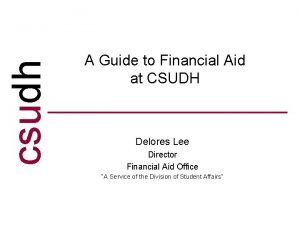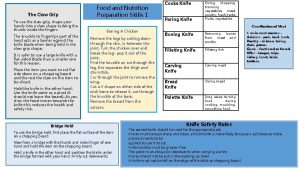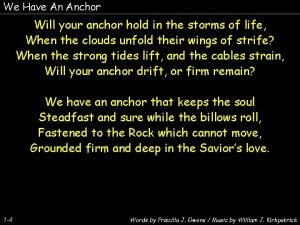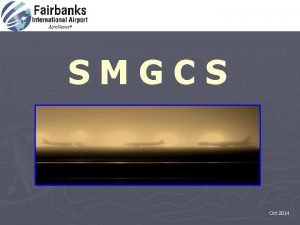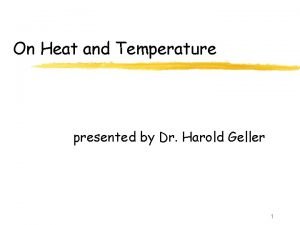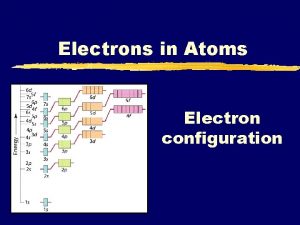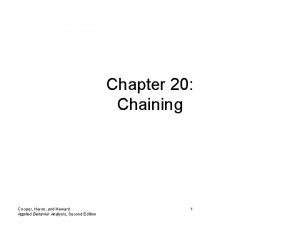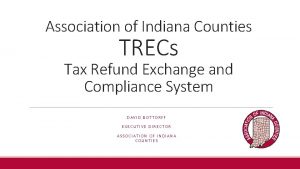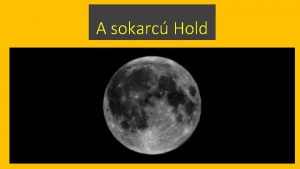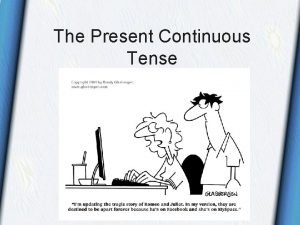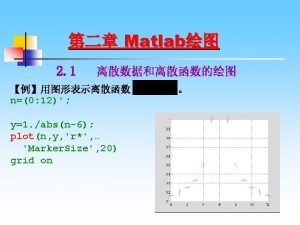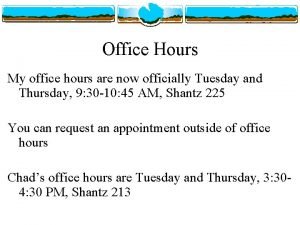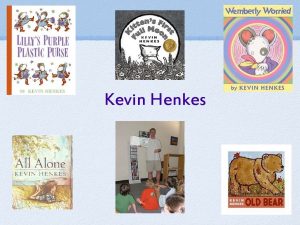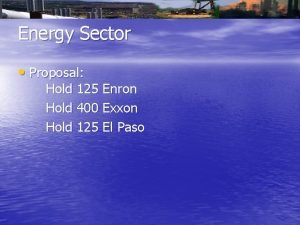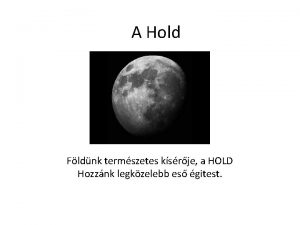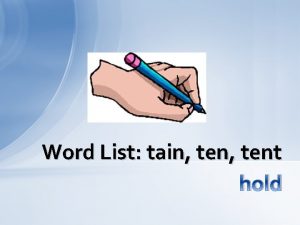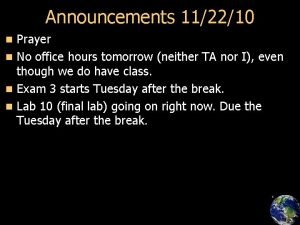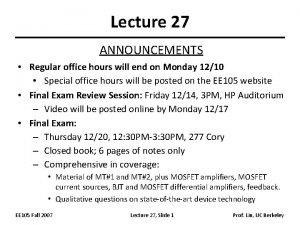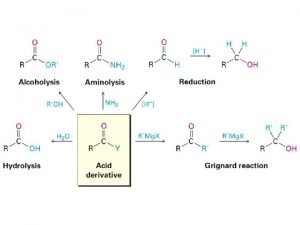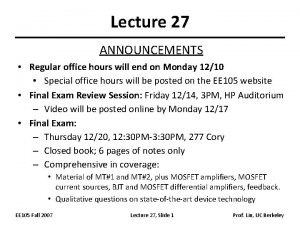Announcements Kevin and I will hold office hours
















































- Slides: 48

Announcements Kevin and I will hold office hours together today in Girvetz 2307 • Michael Pollan article to read for section this week •

Summary from Friday Definition of soil • Soil development • • additions, losses, transformations, and translocations • Classification of soil • 12 different orders Factors of soil formation: Cl. O. R. P. T. H. • Biomes • • function of temperature and moisture


Two-Minute Quiz During your spring break you decide to take a road trip through 18 states in 7 days. Early one morning in the middle of the week you wake up and realize that you can’t remember where you are. You step outside to investigate your surroundings, and notice a lovely road cut where the soil profile is visible from “O” horizon to bedrock.

Here are your observations: • • • The soil is dark red and clayey. The profile is deep. There are rolling hills, but no sharp peaks in the distance The temperature is 65° F. The air is humid, and the vegetation is lush.

Where are you? a) b) c) d) e) upstate New York near Ames, Iowa down a backcountry road in Georgia along the coast of Maine near the border of New Mexico in Arizona

Biome: A large climatic region where plants are similar to each other


What is missing?


Arctic Tundra: § Short growing season § Intense cold § Strong winds § Permafrost § Low primary productivity § Slow decomposition

Boreal forest: § Cold winters, warm summers § Cone-shaped trees - shed snow - catch light § Peatlands - slow decomposition § Fire

Temperate forest: § Evergreen and deciduous § Intermediate temperature § Adequate moisture § Few constraints on growth High primary productivity

Grasslands: § Continental regions hot summer, low rainfall § Fires § Grazing -

Deserts: § North and south of tropics § Dry § Hot or cold Organisms have adapted to this environment

Plant adaptation to hot environments: Physical Structure

Plant adaptations: Physiology Stomata must be open to take in CO 2 • Open stomata = water loss • How can a plant minimize water loss? • • Keep stomata closed as much as possible • Open only at night = CAM plants • Cactus, some epiphytes, succulents • Open only a little bit = C 4 plants • Some grasses


Which grasslands are likely to be C 4?

Tropical Rainforests

Tropical rainforests: § Near the equator § Hot § Moist conditions § High primary productivity § Fast decomposition § Tight cycling of nutrients - soils are actually quite poor

Where is Santa Barbara?

Chaparral or Mediterranean-type • Strong seasonality • Hot, dry summers • Mild, wet winters high productivity • Fires feed on large fuel supply

Announcements I will be gone on Friday – Theresa and Kevin will be giving presentations • Read the Michael Pollan article for section. It is now available online too. •

Summary from Monday Biome= climatic region where the vegetation is similar • Hadley Cells • Terrestrial Biomes • • Arctic Tundra Boreal Forest Temperate Forest Grassland Desert- physical and physiological adaptations of plants Tropical Rainforest Mediterranean/Chaparral

What is missing?

Aquatic Ecosystems • • • Streams and Rivers Lakes Estuaries Freshwater wetlands Oceans

Streams and Rivers

Streams and Rivers 1 st order (headwaters) 2 nd order 3 rd order 4 th order 5 th order

How do large and small streams differ? • Low stream order (i. e. , 1 st or 2 nd order) • • Small, narrow, shallow Steep, fast-flowing rocky bottom Detritivore community breaks down litter High stream order (i. e. , 4 th or 5 th order) • • • Big, wide, deep Shallow slope, slow flowing Processed litter comes from upstream

Production vs. Biomass Pyramids Carnivores Herbivores Primary Producers

Production vs. Biomass Pyramids Carnivores Herbivores Primary Producers Productivity Standing Biomass

Production vs. Biomass Pyramids Carnivores Herbivores Primary Producers Productivity Standing Biomass How do these pyramids differ in terrestrial vs. aquatic ecosystems?

Light Penetration in Lakes Euphotic zone Secchi disk Aphotic zone Sediment eu: well or good a: without

Thermal Stratification of Lakes Summer Epilimnion Hypolimnion Sediment Thermocline

Thermal Stratification of Lakes (wind) Summer Fall Epilimnion Hypolimnion Sediment Epilimnion Thermocline Hypolimnion Sediment

Thermal Stratification of Lakes (wind) Summer Fall Epilimnion Hypolimnion Sediment Epilimnion Thermocline Hypolimnion Sediment Winter Well-mixed profile Sediment

Thermal Stratification of Lakes (wind) Summer Fall Epilimnion Hypolimnion Sediment Epilimnion Thermocline Hypolimnion Sediment Winter Spring Well-mixed profile Sediment

Thermal Stratification and Oxygen Summer Epilimnion Hypolimnion Sediment Winter Well-mixed profile Sediment

Phytoplankton and abiotic factors in a lake

Oligotrophic vs. Eutrophic Lakes

Wetlands: where water meets land All wetlands are ecotones • • • Salt marshes: costal, brackish Swamps: wooded, fresh water Fens: external water and nutrient inputs • • dominated by sedges Bogs: little external nutrient input • dominated by sphagnum moss

Wetland Biogeochemistry

Wetland Biogeochemistry • When land is flooded, O 2 gets used up by decomposers and the soil becomes anaerobic

Wetland Biogeochemistry • • When land is flooded, O 2 gets used up by decomposers and the soil becomes anaerobic Demand for O 2 is still high

Wetland Biogeochemistry • • • When land is flooded, O 2 gets used up by decomposers and the soil becomes anaerobic Demand for O 2 is still high Other minerals containing oxygen get reduced

Wetland Biogeochemistry • • • When land is flooded, O 2 gets used up by decomposers and the soil becomes anaerobic Demand for O 2 is still high Other minerals containing oxygen get reduced • • Reduction is when a compound gains an electron- in this case by giving up an O 2 atom Some molecules release O 2 more easily than others O 2 NO 3 - Fe(OH)3 Mn. O 2 SO 42 - CO 2

Wetland Biogeochemistry • • • When land is flooded, O 2 gets used up by decomposers and the soil becomes anaerobic Demand for O 2 is still high Other minerals containing oxygen get reduced • • Reduction is when a compound gains an electron- in this case by giving up an O 2 atom Some molecules release O 2 more easily than others O 2 NO 3 - Fe(OH)3 Mn. O 2 SO 42 - CO 2 • If the water level drops, O 2 enters the soil again, and the reduced substances can get oxidized
 Hold fast kevin major
Hold fast kevin major Pvu announcement today
Pvu announcement today R/announcements
R/announcements Church announcements
Church announcements Fahrenheit 451 pages
Fahrenheit 451 pages Kayl announcements
Kayl announcements General announcements
General announcements Twu web advisor
Twu web advisor Kent state financial aid office
Kent state financial aid office Csudh financial aid number
Csudh financial aid number Instructor office hours
Instructor office hours Factory office layout
Factory office layout Sample and hold funzionamento
Sample and hold funzionamento Hold your horses idiom meaning and sentence
Hold your horses idiom meaning and sentence Setup time and hold time in digital electronics
Setup time and hold time in digital electronics Gssec
Gssec Storage holds for future use
Storage holds for future use Honorably hold a name and standing
Honorably hold a name and standing Chapter 42 gasoline injection diagnosis and repair
Chapter 42 gasoline injection diagnosis and repair Bridge hold and claw grip
Bridge hold and claw grip Dot and hours of service rules
Dot and hours of service rules Pasadena water and power peak hours
Pasadena water and power peak hours Payment systems and working hours
Payment systems and working hours Jerome kevin and seth shared a submarine sandwich
Jerome kevin and seth shared a submarine sandwich You were the word at the beginning
You were the word at the beginning Will your anchor hold in the storms of life
Will your anchor hold in the storms of life Head high lyrics
Head high lyrics The center cannot hold anarchy is the only hope
The center cannot hold anarchy is the only hope Sbd student required info
Sbd student required info Instrument hold line
Instrument hold line O romeo
O romeo Hold thy desperate hand
Hold thy desperate hand Romeo and juliet poem
Romeo and juliet poem The capacity of air to hold water vapor
The capacity of air to hold water vapor Explanatory
Explanatory Holding process
Holding process Hold to god's unchanging hand history
Hold to god's unchanging hand history Hold fast the traditions
Hold fast the traditions What is energy level in electron configuration
What is energy level in electron configuration Behavior chain interruption strategy example
Behavior chain interruption strategy example Chapter 15 section 2 the second new deal
Chapter 15 section 2 the second new deal Trecs local gov clearinghouse
Trecs local gov clearinghouse Wind tetrahedron
Wind tetrahedron A sokarcú hold
A sokarcú hold Full nelson hold
Full nelson hold You hold my every moment
You hold my every moment Present simple of hold
Present simple of hold The mice very unhappy story
The mice very unhappy story Screw examples
Screw examples









